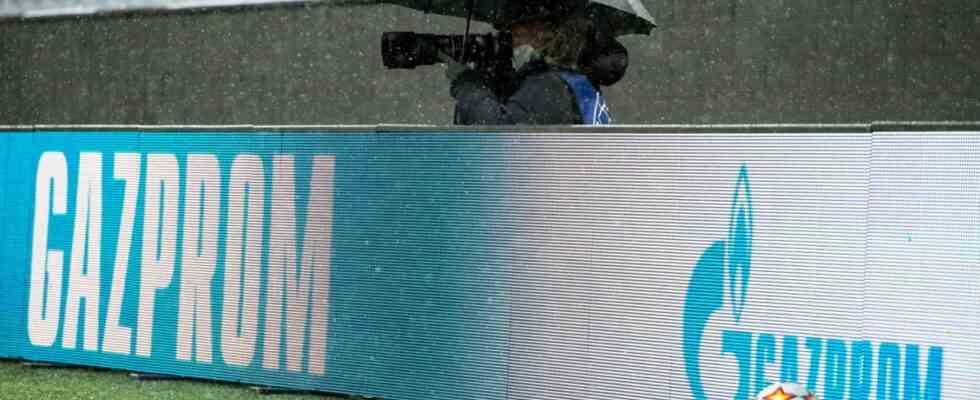Advertising gang with Gazprom: Schalke 04 has already terminated the partnership.
(Photo: Martin Hangen / imago)
It was only six months ago that the Russian gas company Gazprom was still a “very high-quality customer” for Linde. Sanjiv Lamba, now CEO of the Dax group, praised (then as a simple board member) the good business relations with the Russians. The reason: The German-American gas supplier received two prestigious orders from Gazprom in November 2021 – worth around six billion dollars. This is also a considerable volume for the global Linde group. “We are very happy with these projects,” Lamba said at the time.
In the meantime, Linde may no longer be so happy with his relations with Gazprom. In a relatively short time, the group has gone from being a potential customer to a problem customer. Last year, Linde was awarded the contract for the planning and construction of an LNG liquid gas plant and a gas processing plant near Ust-Luga, which is not far from the Russian border with Estonia. Since Russia’s attack on Ukraine and the brutal war, the state-owned company Gazprom has been under particular criticism. Its subsidiary in Germany is already being managed by the Federal Network Agency as a trustee, and Gazprom has been out as a sponsor of Schalke 04 for weeks. Hardly anyone else wants to have anything to do with Gazprom.
The sale of industrial equipment in Russia is under consideration
Linde condemns the attack on Ukraine and supports the employees and their families in the country, the company said. Shortly after the beginning of the war, Linde had already announced that it would stop new business and the acquisition of orders in Russia. Now the project development is being further reduced and even the sale of industrial plants in the country is being examined, it was said recently. However, the supply of important customers with life-saving medical and other gases will continue. Linde also supplies hospitals, among other things, both in Russia and in the Ukraine. The group is fully compliant with all existing and future sanctions against Russia. Gazprom will in the opinion not explicitly mentioned.
The major order with Gazprom, which is to run for several years, has so far been processed step by step. The Russians pay for sections, while Linde plans, supplies and builds. In this context, the billion dollar business is apparently still being processed – until further notice. According to reports, Linde currently has to stick to the existing agreements and does not want to breach the contract, which could result in high fines. In addition, based on previous orders, the group has a stake in a plant as part of the “Power of Siberia” pipeline project, which is intended to connect natural gas fields in eastern Siberia with north-eastern China.
First test: Sanjiv Lamba has been head of the Linde Group since March.
(Photo: Linden/oh)
Not an isolated case: Siemens, for example, announced soon after the start of the war in early March that new business in Russia would be discontinued and that there would also be no more international deliveries from the country. However, maintenance and service in Russia will continue for the time being. Among other things, the Munich-based group has delivered high-speed trains to Russia. After all, Siemens has been active in Russia since 1851.
If further sanctions also make it impossible to complete the Gazprom order, Linde’s project will have to be put on hold, which cannot be ruled out. The loss of the billion-offer would definitely hit Linde. It is now considered unlikely that the order can be completed in full. At the end of April, Linde will publish quarterly results, so there could be more information.
The international pressure is growing
In any case, the international pressure on the corporations to turn their backs on Russia is constantly growing, not only in Europe but also in America. McDonald’s, for example, and Coca-Cola left the country long ago. Linde has its operational headquarters in the United States. In 2019, the traditional Munich company merged with the smaller American competitor Praxair – on an equal footing, as it was called at the time. The name has stuck, but since then the music has mainly played in the USA. Even if Linde is still a member of the German stock index Dax and is the most valuable company there with a market capitalization of almost 150 billion euros – ahead of SAP. After initial hesitation, the software group has now completely withdrawn from Russia.
Linde is the world market leader and supplies industrial gases to the automotive, oil and chemical industries as well as to food manufacturers and the healthcare sector. At the same time, however, there is a smaller unit, which is located in Höllriegelskreuth in the south of Munich, among other places, which plans and builds large-scale industrial plants. After the merger, there was initial speculation that this area should be sold because the margins are lower than in the pure gases business. In the meantime, however, plant construction is developing well, as the large order also showed. Among other things, Linde can plan and build liquid gas plants. So-called LNG terminals are currently in great demand everywhere because Europe wants to become independent of pipeline gas from Russia. Linde also specializes in projects involving hydrogen production and supply.
Gazprom is the first test for Sanjiv Lamba, the long-time Linde board member has only been CEO since March of this year. Lamba’s predecessor, Steve Angels, moved to head the board. Wolfgang Reitzle, who has held this job since the merger, has retired. Linde recently had annual sales of around 30 billion euros.

